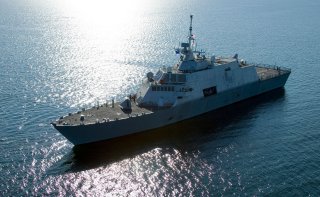How the U.S. Navy Plans to Find and Destroy Enemy Sea Mines
The expanding number and types of enemy mines are a real threat.
Sea mines are deadly. They explode on impact or from sensors buried beneath underneath the ocean floor. They can also be used in both shallow and deep water passageways to deny or complicate access to vital areas. In fact, sea mines are increasingly available to militaries around the world.
The presence of sea mines and fast proliferation among hostile countries continues to push the U.S. navy’s ongoing effort to craft modern mine warfare plans and engineer drones able to find and detonate them before they can hit manned vessels.
Part of this Navy effort includes the acquisition of drone-towed sonar technologies intended to hang beneath mine-sweeping Unmanned Surface Vessels often operating in groups. The Navy recently awarded a deal for future AN/AQS-20 surface-towed sonar systems to support the service’s growing family of USVs. The awards went to Advanced Acoustics Concepts, Arete Associates, Northrop Grumman and Peraton, a Navy report said.
“Deliverables include trade studies, test and verification studies, product improvements plan, Technical Data Package analysis, and obsolescence reviews to ensure production and delivery of a mature, fully integrated system that meets Fleet requirements,” the report states.
This Navy approach, and its corresponding warfare technologies, will in part be executed by elements of the Navy’s Mine Countermeasures (MCM) Mission Package for the Littoral Combat Ship. This includes MH-60 helicopters, deck-mounted drones such as the Fire Scout, surface sweeping drone boats such as Textron’s Unmanned Influence Sweep System and deep diving drones engineered to detect mines buried beneath the ocean floor, such as the Knifefish.
There are a variety of ways in which the Navy’s mine-warfare strategy is quickly becoming more manifest, including video-guided undersea drone explosives, unmanned weapons, sensors and advanced airborne countermine technologies engineered to destroy mines beneath the surface.
Other undersea drones, such as Raytheon’s Barracuda, are engineered to operate semi-autonomously undersea, using guidance systems to find enemy mines and then dispatching explosives to destroy them without requiring human intervention. Some of the more recent innovations include Northrop’s AQS-24 which uses underwater laser side-scanning.
There are various types of mines that need to be found, to include more visible or “find-able” mines. These have a strategic and operational value, even if they are less covert. Of course, visible mines could be missed by an enemy or overlooked in some way, yet they can function as weapons intended to “deny” an enemy access to a strategically vital location or asset. Covert mines, by comparison, would likely function with the more narrowly-configured intent to avoid detection and simply harm an enemy without being detected.
The overall MCM system is slated to be operational by 2022, however some elements are already available.
Kris Osborn is the defense editor for the National Interest. Osborn previously served at the Pentagon as a Highly Qualified Expert with the Office of the Assistant Secretary of the Army—Acquisition, Logistics & Technology. Osborn has also worked as an anchor and on-air military specialist at national TV networks. He has appeared as a guest military expert on Fox News, MSNBC, The Military Channel, and The History Channel. He also has a Masters Degree in Comparative Literature from Columbia University.
Image: Reuters.

